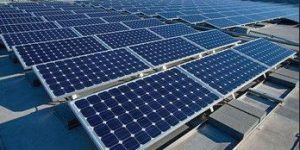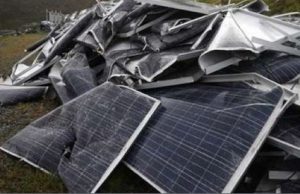Solar panels are getting bigger and faster every day. As the world heads towards replacing conventional electricity production with, what is described in the mainstream as, alternative energy, the production of photovoltaic’s is changing on almost a daily basis. Let me first start by saying there’s no such thing as alternative energy. Energy is energy regardless of where it comes from, however some sources of production are more desirable than others. Reasons why one source may be more desirable than another are manifold however the less impact the generation of electricity for commercial and private consumption has on the immediate environment the better.
Hidden amongst the deleterious impact that the production of so called alternative electricity will have into the future has not always been publicly rea lised.
lised.
All solar panels have a finite lifespan as the second law of thermodynamics dictates. The disposal and hopefully the recycling of the materials used in solar panels is a potential time bomb that will start impacting various countries in the near future and will most certainly be a significant issue that will need dealing with en masse within the next 20 to 25 years. “A high technology society is a high polluting society” and frequently separating various components from within a manufactured product is not economically viable.
Solar panels, or more accurately, photovoltaics, are one such product.
Apart from the energy hungry production methodologies being used to produce photovoltaic panels, which in turn requires several years of productive life for “payback time”, the economic reality is that panels that have passed their use by date is an expense that may not have been accurately factored in.
Japan, coincidentally named “the land of the rising sun, got busy pioneering the use of solar energy before the turn of the century. By the time 2001 had turned up solar power production in Japan was 500% higher than it was in the 1990s. A large percentage of Japanese photovoltaics were manufactured in another country, no guesses where that was, and the energy efficiency and life expectancy of the panels produced at that time fell way short of what they do nowadays.
>>>LEARN MORE>>>
Of course being the first cab off the rank, that is, being pioneers into a new industry, you don’t always have the most efficient “mouse trap” possible and, as a consequence you will end up having to solve a waste disposal dilemma decades before others can learn from your mistakes.
Incidentally Japan has 54 nuclear reactors with safety records akin to Queensland’s Dreamworld. Everyone should remember what happened at Fukushima in 2011and know that the environmental issues precipitated from radioactive wastes let loose to run amuck are a long way from over even if they’re not mentioned in contemporary modern media, ie. the 6 o’clock news.
Even as far back as 2016 the Japanese government acknowledged that it will have over 80 0000 tonnes of solar panels that will have passed their use by date by 2040. Worldwide it is anticipated that there will be close to 100 million tons of solar panel waste only a decade after that.
This may have been one journey that was started without the end or destination in mind because this is going to be a major drama in the not too distant future. These costs most certainly haven’t been factored in. In a get rich quick world it appears that the next generation is going to have to pick up the tab along with the other environmental costs.
The good news is that solar panels are becoming more efficient as the number of kilowatt hours produced over the life expectancy increases and therefore the tonnage of waste per unit of energy generated is reduced. That doesn’t solve the imminent waste problem but it will reduce the size of the impact into the future.
JA Solar, a Chinese manufacturer, showcased an 800 watt solar panel in Shanghai at the SNEC Power Expo which is expected to go into mass production by early 2021.
Yes they are bigger panels than the 190 watt panels that were around a decade ago but they are also significantly more efficient generating less waste into the future.
 Other major manufacturers are gearing up to produce panels from 540 Watts to as much as 780 Watts. Jinko Solar panels have become quite popular in Australia and the company has released a 610 watt panel with an efficiency of 24.8% which at the time of writing is the most efficient N-Type monocrystalline silicon solar cell. >>>LEARN MORE>>>
Other major manufacturers are gearing up to produce panels from 540 Watts to as much as 780 Watts. Jinko Solar panels have become quite popular in Australia and the company has released a 610 watt panel with an efficiency of 24.8% which at the time of writing is the most efficient N-Type monocrystalline silicon solar cell. >>>LEARN MORE>>>
Of course if you want to get 27.3% efficiency, a material that first appeared in 2009 and went on to make headline news back in 2013 called perovskite could be the answer. Wikipedia says that perovskite is a “calcium titanium oxide material composed of calcium titanate”.
Studies done at both Oxford University and the University of Pennsylvania suggest that efficiencies could be as high as 50% and the materials used, being carbon and lead are significantly less of a future pollution issue than conventionally produced silicone cells.
To reduce the already significant and inevitable impact of dealing with solar panel waste, having less polluting, more efficient solar panels that are more easily recycled is most certainly a move in the right direction.
John Lynn
